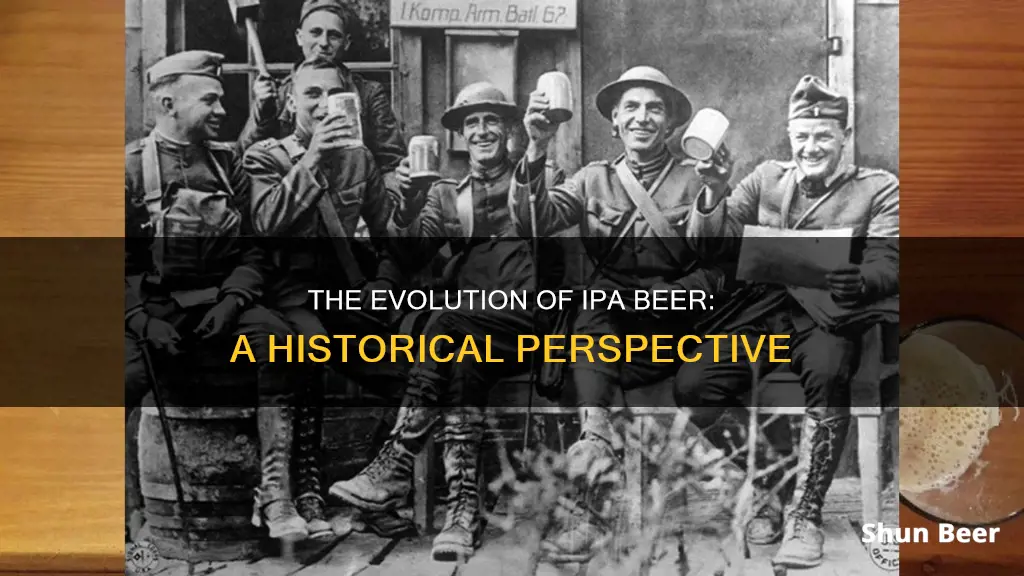
India Pale Ale (IPA) is a hoppy beer style within the broader category of pale ales. It was originally an export beer shipped to India, which was under the control of the British East India Company until 1858. The beer was formulated to survive the long voyage from England to India better than other beer styles of the time. The first brewer known to export beer to India was George Hodgson of the Bow Brewery in London. Hodgson's beer was imitated and improved upon by bigger brewers, and by the 1860s, India Pale Ales were widely brewed in England. However, with the advent of refrigeration in the late 19th century, IPAs became less common. It wasn't until the 1970s that American brewers revived the style, creating new varieties with higher alcohol content and more hops. Today, IPAs come in many styles, such as Session IPAs, Double IPAs, and New England IPAs, and they are enjoyed by beer drinkers around the world.
| Characteristics | Values |
|---|---|
| Name | India Pale Ale (IPA) |
| Origin | The popular origin story is that George Hodgson of the Bow Brewery in London first brewed the beer in the late 18th century. However, this is a simplified version of what really happened. |
| Reason | Beer was spoiling during the long sea journey from England to India. |
| Solution | Extra hops and an increased alcohol content helped preserve the beer. |
| Result | A bitter and stronger pale ale that was more refreshing in the hot Indian climate. |
| Popularity | By the early 19th century, India Pale Ale was gaining popularity in England, becoming one of the country's best-selling beers by 1840. |
| Decline | The popularity of India Pale Ales in England waned by the start of the 20th century due to new styles entering the market and increased taxes on higher-gravity beers. |
| Revival | American brewers in the 1970s and 1980s revived the original recipes while adding new styles of hops. |
| Modern IPA | Today, IPA is one of the most popular beer styles in the UK and the US, with various styles such as West Coast IPA, East Coast IPA, and New England IPA. |
What You'll Learn

IPA was originally an export beer shipped to India
India Pale Ale (IPA) was originally an export beer shipped to India, which was under the control of the British East India Company until 1858.
The pale ales of the early 18th century were lightly hopped and quite different from today's pale ales. By the mid-1700s, however, pale ale was mostly brewed with coke-fired malt, which produced less smoke and roasting of barley in the malting process, resulting in a paler beer. One such variety was October beer, a well-hopped brew popular among the landed gentry, which was intended to be cellared for two years.
Among the first brewers known to export beer to India was George Hodgson's Bow Brewery, located on the boundary of Middlesex and Essex. Its beers became popular among East India Company traders in the late 18th century due to its proximity to the East India Docks and Hodgson's liberal 18-month credit line. Ships exported this beer to India, including his October beer, which was highly regarded by its consumers in India.
Burton breweries, which had lost their export market in Continental Europe, sought a new market for their beer. At the request of the East India Company, Allsopp's brewery chief maltster, Job Goodhead, developed a strongly-hopped pale ale in the style of Hodgson's for export to India. Other Burton brewers, including Bass and Salt, followed suit, taking advantage of the benefits of Burton water in brewing similar beers.
London East End brewer Charrington's trial shipments of "India Ale" to Madras and Calcutta in 1827 proved successful, and regular trade emerged with key British agents and retailers. Early IPAs were only slightly higher in alcohol than other beers at the time, but more of the wort was fermented, resulting in fewer residual sugars, and they were heavily hopped.
While IPAs were formulated to survive long voyages by sea, porter was also successfully shipped to India and California. By the 1860s, India Pale Ales were widely brewed in England, and they were much more attenuated and hopped than porters and ales. Demand for the export style of pale ale, now known as "India Pale Ale", developed in England around 1840, and IPA became a popular product there.
Guinness Beer: Flavors and Varieties You Need to Try
You may want to see also

George Hodgson's Bow Brewery was the first to export beer to India
Hodgson began by selling his porter to the ships' captains and then expanded his offerings to include a paler beer known as October beer, which was popular among the middle and upper classes. Technically, the October beer was sold to the sailors unmatured, as it usually took a year before it could be bottled and then another year before it was ready to drink. However, no one anticipated the effects of the long voyage to India on the beer. The warmer temperatures and the constant movement of the ship during the journey had a remarkable impact on the October beer. By the time it reached India, it had matured much more quickly than it would have on land, transforming into a new kind of drink that ultimately became pale ale.
Over time, the Bow Brewery's ale became incredibly popular in India, and the brewery's reputation flourished. By 1811, Hodgson's son, Mark, was in charge, and the brewery was shipping over 4,000 barrels of beer a year to India, a significant increase from just a few years before. The success of the Bow Brewery's ale in India was due to a combination of its convenient location near the docks, the generous credit terms offered to ship captains, and the unexpected benefits of the long sea voyage on the beer's flavour and maturation process.
Guinness Beer: A Low-FODMAP Diet-Friendly Drink?
You may want to see also

Early IPAs were only slightly higher in alcohol than other beers
The history of India Pale Ale (IPA) is a fascinating one. The beer style originated in the late 18th century when George Hodgson of the Bow Brewery in London began exporting a strong, heavily hopped beer called October ale to India. This beer, which was aged like wine before drinking, survived the long sea journey and was found to have improved in flavour. This success led to the development of the first IPAs, which became popular in India due to their pale, refreshing qualities in the hot climate.
While early IPAs were slightly higher in alcohol than other beers of the time, they were not significantly stronger. At around 6.5% alcohol by volume, they were slightly weaker than average. However, they had a higher level of fermentation, resulting in fewer residual sugars, and were heavily hopped. These characteristics helped the beer survive the long voyage to India and provided a refreshing drink for British soldiers, sailors, and civilians in the colonial outpost.
The popularity of IPAs grew, and by the early 19th century, they were widely consumed in England as well. The beer style evolved, and weaker pale ales were produced for the domestic market. However, with the advent of refrigeration in the late 19th century, IPAs became less common. It wasn't until the 1970s that IPAs experienced a revival, thanks to American craft brewers who began experimenting with new hops and higher alcohol content.
Today, IPAs are once again popular worldwide, with various styles such as Session IPAs, Imperial IPAs, and New England IPAs. The original IPAs may have had a modest alcohol content, but modern variations can range from moderate to strong, showcasing the versatility and enduring appeal of this historic beer style.
IPA Beer and Food Pairing: A Match Made in Heaven
You may want to see also

IPAs were formulated to survive long sea voyages
George Hodgson's Bow Brewery in East London began sending its pale ale to India in the late 18th century. Hodgson's beer was packed with extra hops and had an increased alcohol content, which helped preserve it during its long sea journey. This created a bitter and stronger pale ale that was more refreshing in the hot Indian climate compared to the dark ales and porters popular in London.
Hodgson's beer was successful, and he held a monopoly on the market for about 50 years. However, other breweries also began to export beer to India, and by the early 19th century, "pale ale prepared for the India market" was gaining in popularity. The first known recorded mention of the phrase "India Pale Ale" was in 1835 in an edition of the Liverpool Mercury.
The formulation of IPAs allowed them to survive the long voyage from England to India, making them a popular choice for export.
Antioxidant Power of IPAs: Beer's Healthy Twist
You may want to see also

The revival of IPA in modern times
The Ballantine IPA, which had been made in the US since 1890 until the 1990s, proved to be a source of inspiration for American brewers. The traditional IPA style, with its strong flavour and aroma, was well-suited to showcase the intense characteristics of American hops. Bert Grant of Yakima Brewing and Malting identified that Cascade and Chinook hops, grown locally in Yakima, Washington, provided robust flavours when used in an IPA.
The popularity of IPA began to spread across the United States, particularly along the West Coast, and eventually gained traction worldwide. Today, it is estimated that over 40% of craft beer brewed in the US can be classified as an IPA.
The revival of IPA can also be attributed to a seminar on Burton pale ales organised by publican Mark Dorber in 1990. This seminar sparked a series of festivals and conferences dedicated to celebrating and exploring IPA, bringing together brewers from both sides of the Atlantic.
The influence of American craft brewers on the modern IPA cannot be overstated. They experimented with new styles of hops, higher alcohol content, and different ingredients, creating a wide range of IPA styles that continue to evolve and captivate beer enthusiasts around the world.
Guinness Nitro Beer: What Are Those IBUs?
You may want to see also
Frequently asked questions
IPA stands for India Pale Ale. It is a hoppy beer style within the broader category of pale ales.
The British in India, separated by at least six months of sailing from their homeland, wanted to drink beer. However, the porter they were accustomed to drinking could not survive the long journey. George Hodgson's Bow Brewery in London, the East India Company's main porter supplier, experimented with different techniques to overcome this issue. In the 1780s, Hodgson started selling a strong, pale beer called barley wine or "October beer", which continued to age during the voyage and was found to have improved by the time it reached India. This was the prototype IPA, and the recipe was tweaked over time, resulting in several varieties, including a weaker pale ale produced for the British market.
With the advent of commercial refrigeration in the late 19th century, which revolutionised the shipping of perishable goods, IPAs became less common.
Almost two centuries after the first IPA was brewed, Americans revived IPAs with the cultivation of a new type of hops, Cascade hops, which were released to the public by the U.S. Department of Agriculture in 1972. Three years later, in 1975, the strong citrus flavour of Cascade hops was infused into the first American pale ale, which was brewed by Anchor Brewing Company in San Francisco and sold as Liberty Ale. This product led to a craft beer frenzy in the United States and paved the way for a resurgence of IPAs.
Some popular styles of IPAs include Belgian IPAs, Black IPAs, British or English IPAs, Brut IPAs, Lactose/Milkshake/Cream IPAs, New England IPAs, and West Coast IPAs.







